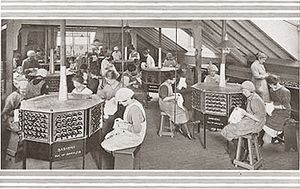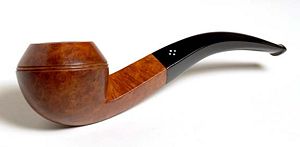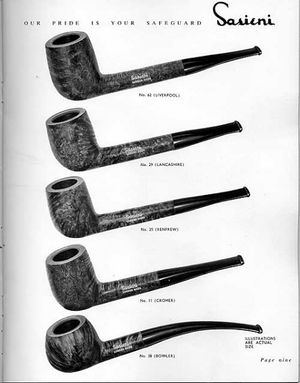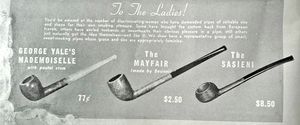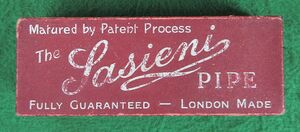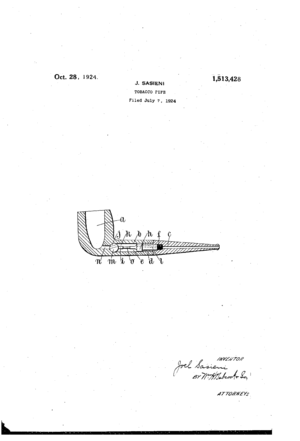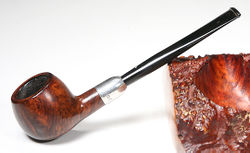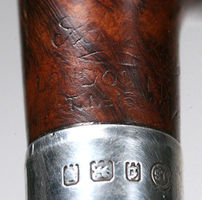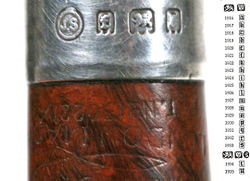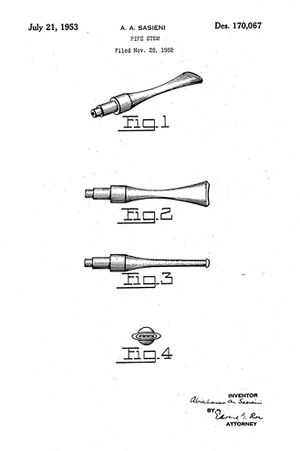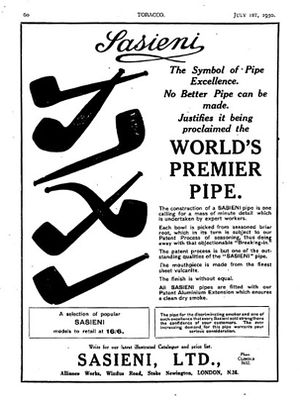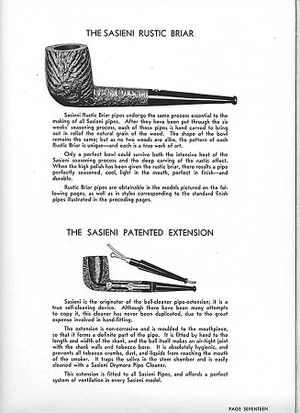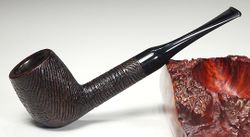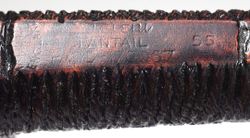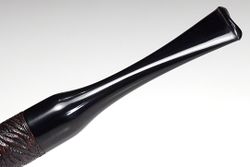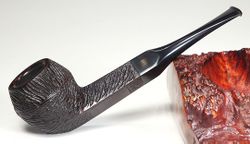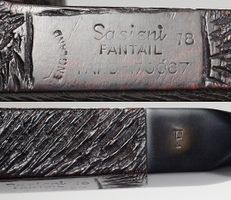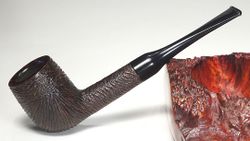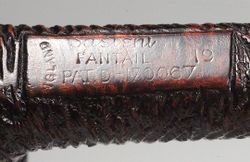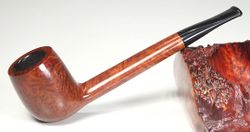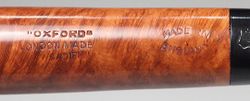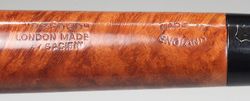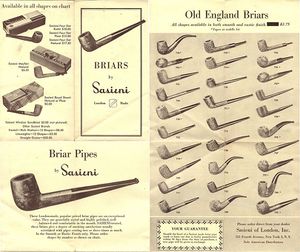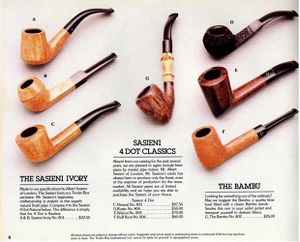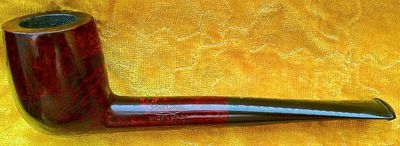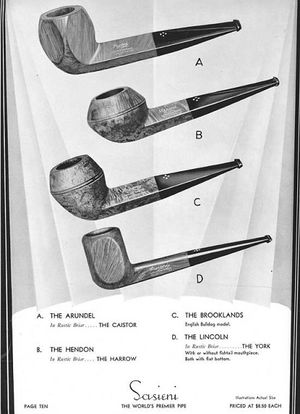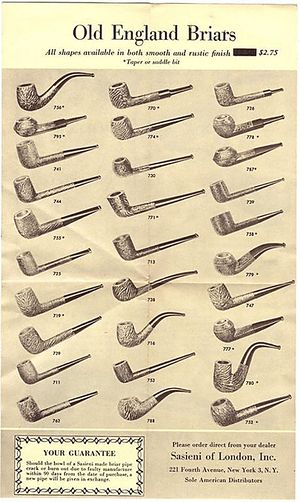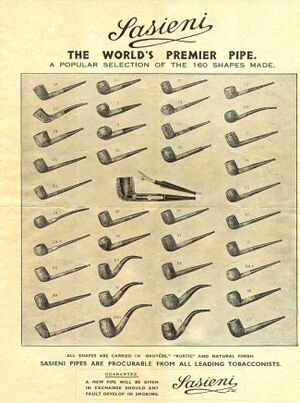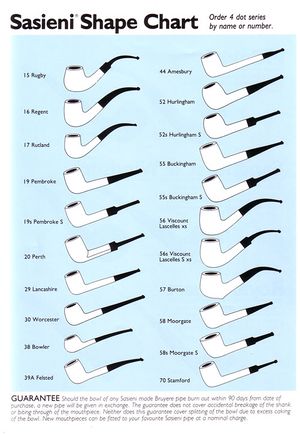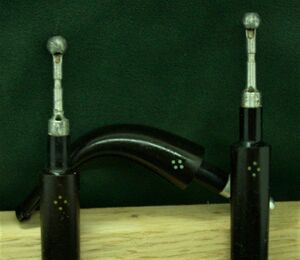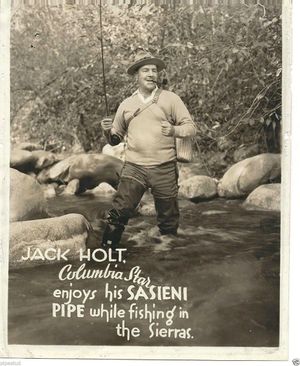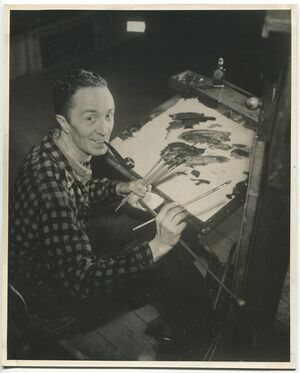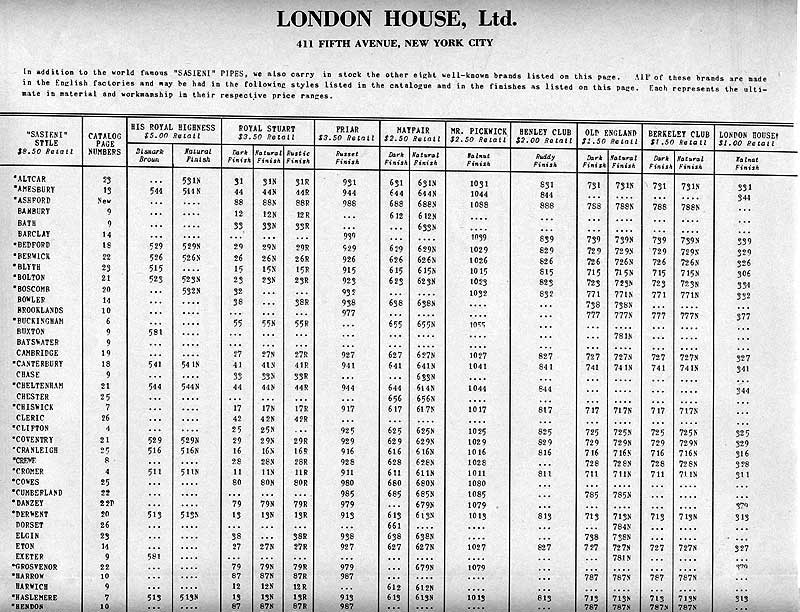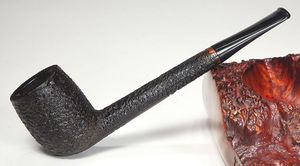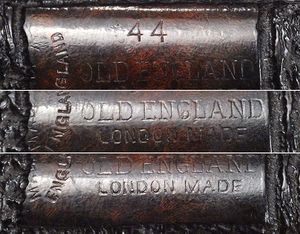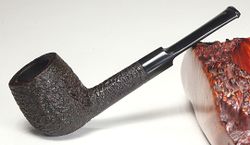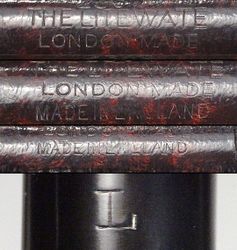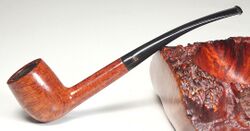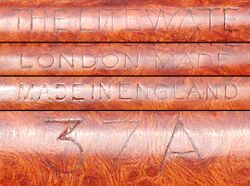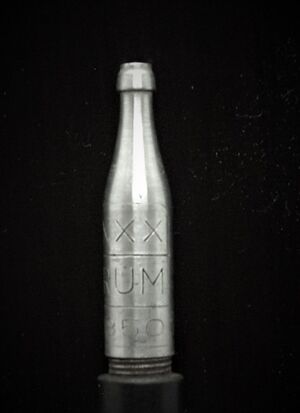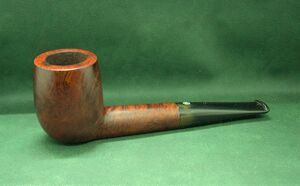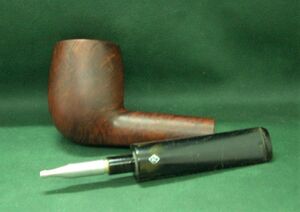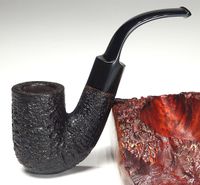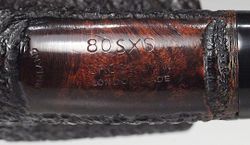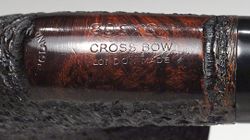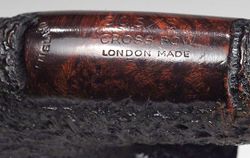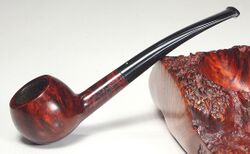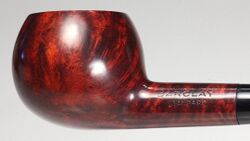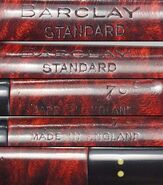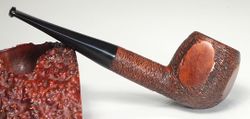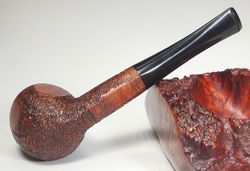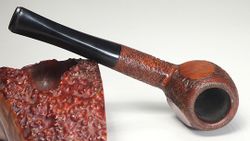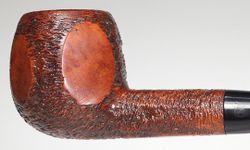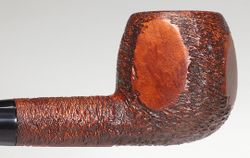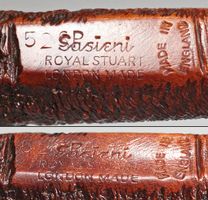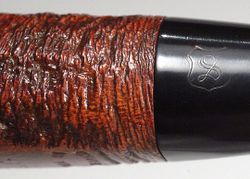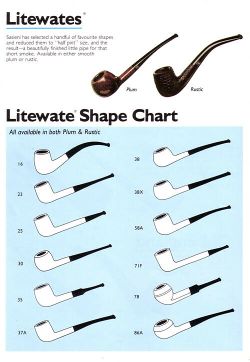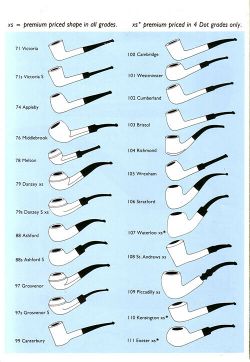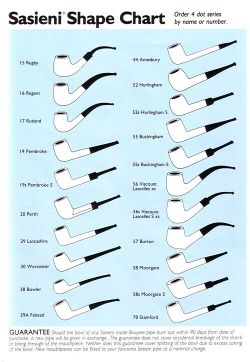Sasieni
The following article is from Stephen P. Smith's Connecting the Dots and used by permission. Please feel free to contribute additional information, but do not edit or delete the material within Steve's article -- Pipedia SYSOP
Connecting the Dots: A Concise History of the Sasieni Pipe
By Stephen P. Smith
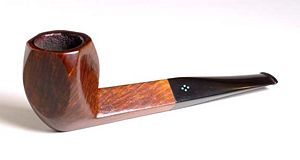
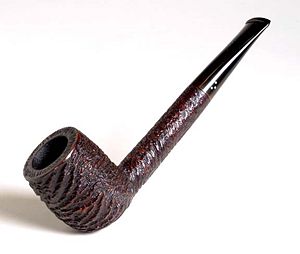
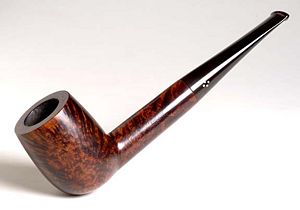
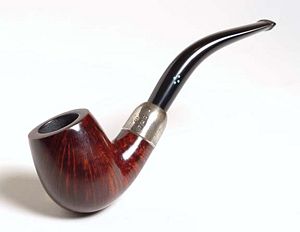
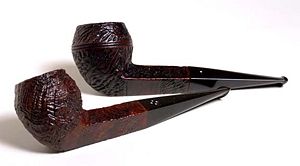
In his book, “The Ultimate Pipe Book”, Richard Carleton Hacker writes American pipe collectors “seem to be more preoccupied with ’smokable’ brand names, of which the most collectible are Dunhill, Barling, Sasieni, and Charatan.” Theodore Justin Gage, the former publisher of the much missed “The Compleat Smoker”, called Sasieni pipes a “fascinating collectible, …representing all that is good about classic English pipe making.” And for good reason: the pipes made by the Sasieni company between the years 1919 and 1979 rank among the very best the London pipe industry had to offer. They featured superb wood, flawless bowls, outstanding smoking qualities, and a styling that was uniquely theirs.
Yet for all that, Sasieni’s are among the most underrated pipes on the collectible market, usually selling for far below their real worth. In this, they offer the astute collector a genuine opportunity, whether he or she is looking for a pipe with potential for appreciation, or simply a great pipe at a reasonable price.
However, in order for the collector to capitalize on this, it is vitally important to realize the Sasieni company changed hands on two occasions, and each owner had different priorities and agendas. Not surprisingly, this was reflected in the quality of the pipes made during these different times. All bore the Sasieni name, and yet they were very different pipes.
It is possible to divide the Sasieni history into three eras, similar to Barling. In fact, throughout this article, I will be referring to “Pre-Transition, Transition, and Post-Transition” Sasieni’s. While this may raise a few eyebrows, I believe it will become clear these classifications are actually quite appropriate.
Therefore, it will also become clear a collector must be able to distinguish between Sasieni’s of different eras, as it is mainly the family made pieces made between 1919 and 1979 which are truly desirable to collectors. The dual purposes of this article, then, are to trace the history of the Sasieni pipe, and to enable collectors to judge, with a reasonable degree of certainty, when the Sasieni in question was made.
A Brief History of the Sasieni Company
There is a great deal of mystery surrounding the Sasieni pipe, owing largely to the fact there is such a paucity of written information about them, as is the case with many collectible pipes. Even the name of the founder has been subject to debate. One respected source says the founder was named “Joel” Sasieni. Another equally respected source says with equal certainty the name was “Joseph” Sasieni. (A third, rather less reliable source once told me “Joel” and “Joseph” were brothers, but I think we can safely dismiss that.) An old Sasieni catalog which I came maddeningly identifies the founder as “J. Sasieni”. However, some research at the U. S. Patent Office conclusively shows that his first name was Joel.
Joel Sasieni apprenticed at Charatan, and moved on to Dunhill, where he eventually rose the position of factory manager. Many men would have been perfectly satisfied with such a position, but not Mr. Sasieni. He opened up his own factory in 1919, believing he could improve on some of Dunhill’s methods. Mr. Sasieni was, if nothing else, an optimist.
Things did not go smoothly for the new firm. The factory burned down almost immediately. Apparently undaunted, Mr. Sasieni simply rebuilt the factory and carried on.
One change he incorporated in his pipes was the method of curing the bowls. While the briar blocks were air cured, similar to Barling, Sasieni took this process a step further by “oven curing” his pipes. Each pipe was cured in an oven over a period of six weeks, being removed periodically by a factory worker, who would wipe away the moisture as it emerged from the bowl with a rag, and check it for cracks. The end result was Sasieni pipes (the ones that survived) were extremely dry smoking.
Sasieni was not oblivious to the success Dunhill had achieved with its famous “White Spot” logo, and while he obviously couldn’t copy the logo exactly, he apparently saw no problem with reinterpreting it a bit. Therefore, each Sasieni pipe which came out of the factory had a single blue dot in the stem.
Not surprisingly, the idea of their former employee competing with them using a very similar trademark didn’t exactly make Dunhill’s day. They threatened legal action in both the U. K. and the U. S.. Sasieni was saved in England by that country’s rather vague trademark laws, and the Sasieni One Dot continued to be produced for the European market for several decades.
Sasieni was not so fortunate in the U. S., where by the early 1920’s Sasieni had found an enthusiastic audience. In an initial attempt to comply with U. S. patent law, Sasieni moved the one blue dot to the side of the pipe. This unfortunately didn’t do the trick, and only a few side dot Sasieni’s were ever made, which are now extremely rare and collectible.
So, thanks in part to Dunhill’s patent attorneys, one of the most famous logos in the pipe industry was born. To clearly differentiate his pipes from Dunhill’s, and also to distinguish the American market pipes from all others (American market pipes originally only had a three month guarantee, although by the mid 1930’s this was extended to one year) Sasieni put four blue dots on the stem of his pipes, arranged in the shape of an elongated diamond.
The distinctive logo was an immediate hit in the U. S., where it, along with the pipes’ exceptional smoking qualities, helped the pipe to sell in such quantities the factory had trouble keeping up with the demand. In fact, by the 1930’s over 90% of Sasieni’s production was going to American shores.
Ah, but we Americans are a restless lot. We just don’t know when to leave well enough alone. So enamored had the U. S. market become of the four blue dots, the importer wanted to make sure they could be seen by everyone standing on each side of the smoker. Therefore Sasieni, reluctantly by some accounts, agreed to put four more dots on the right side of the stem.
The Sasieni Eight Dot is now the most collectible of all Sasieni pipes, due to both its scarcity and the fact that, unlike other Sasieni’s, the collector can be reasonably certain when the pipe was made. The Eight Dot made its debut in the late 1920’s or very early 1930’s, and was discontinued during W.W.II due to the inevitable shortages of supplies. Like the Four Dot, the Eight Dot had its logo made by individually inserting rods of blue plastic into pre-drilled holes in the stem, similar to the process used by Dunhill for their one white spot.
This was an excruciatingly difficult procedure, even on the Four Dot, for each dot had to be placed just right in order to create the desired diamond shape, and on the Eight Dot, both sets had to be symmetrical. For all that, it is rare to find a an original Sasieni bit in which the dots are even the slightest bit off. This in itself bears testimony to the fastidiousness with which Mr. Sasieni applied his craft. It also makes it fairly easy to spot a fake Sasieni stem.
Both the Eight Dot and the Four Dot were marketed in the U. S. during the pre-war years, with the Eight Dot fetching more money, even though both pipes used the same wood.
The post war years brought many changes at the Sasieni company, not the least of which was the death of Mr. Sasieni himself, in 1946. His son Alfred (named, perhaps, for his father’s arch-rival and former boss?) proved a worthy successor to his fathers’ business, and the company continued to thrive under his leadership. About this time the company started stamping “Four Dot” on the shanks of the pipes, to further capitalize on the now famous trademark’s prestige. There were other changes in both the shank nomenclature and the dots themselves, which will be reviewed in detail later on.
Through the post war years, Sasieni added shapes and lines. While the Four Dot remained their most famous product, the company also sold lines of “seconds” under various names, such as Mayfair, Fantail, Olde English, and Friar. These were pipes made of good wood, but possessed of some flaw, usually filled with putty. Pipes that were almost, but not quite, good enough to be a Four Dot were sold as Two Dots. I have two of these pipes in my collection. Both pipes are quite striking, exhibiting exquisite shapes and exceptional grain. At first I wondered why they were not Four Dots. Eventually, after long inspection, I discovered each pipe contained one very small filled flaw. In spite of this they remain two of my favorite pipes. However, it is clear Sasieni was determined to put the Four Dot logo on only the most perfect pipes.
- 1921 Sasieni Apple, courtesy Doug Valitchka
- Sasieni Fantails and details, courtesy Doug Valitchka
- Sasieni Oxford, courtesy Doug Valitchka
Alfred Sasieni continued to run the company prosperously until 1979, when he sold out to another firm. Interestingly, he stayed on in the capacity of a director. At first it seems to have been a harmonious partnership. The new owners started their tenure with a limited edition reissue Eight Dot. This was a generous sized, natural stained smooth pipe which occasionally also had a gold band. Each pipe had a blue string running through the bowl, shank, and stem, affixed with a lead stamp and paper tab signed by Alfred Sasieni himself. These pipes are both strikingly handsome and maddeningly elusive, due to the fact only 100 (or so, accounts differ) were ever made.
This spirit of cooperation between the old and new owners does not appear to have lasted long. Alfred Sasieni believed only vulcanite should be used for pipe stems, eschewing the newer, trendier Lucite. When the new owners, contrary to Alfred’s wishes, issued a new Ten Dot, replete with Lucite stem, it seems Alfred decided he had had enough, and left the firm for good.
The new owners of what can accurately be called the “Transition” firm continued to create high quality pipes using the old wood and methods they inherited from the Alfred days. However, these pipes are not as collectible as the family pipes, and it is necessary for the collector to be able to differentiate between the two.
The new owners do not appear to have retained their interest in pipe making for very long, as they sold the company again in 1986. Unfortunately, this new, “Post-Transition” firm decided to abandon the high grade market place, and instead transformed the Sasieni into a mid range “smoker”, a metamorphosis from which it has yet to recover. The news owners decided to capitalize on the Four Dot mystique by eliminating all “second” lines, and issuing practically everything under the Sasieni banner as a Four Dot. This had the inevitable effect of lowering the overall quality of the line. For the first time, it was possible to find a Four Dot with a putty fill, which would have been unheard of when the family ran the company. Even the “Transition” firm maintained the integrity of the Four Dot line by marketing flawed pipes under some other line.
Ironically, it is generally agreed the two most active markets in this country today are the “high end” and “low end” markets, with the middle $35-$100 range being the most sluggish–precisely where the new Sasieni’s are now being marketed. Fortunately, fairly obvious changes in the nomenclature–to say nothing of the presence of putty–make it easy to spot a “Post-Transition” Sasieni.
Dating a Sasieni
No, this has nothing to do with asking the pipe to go out to the movies with you. As I have mentioned before, it is important to be able to date a Sasieni which you are contemplating purchasing. Pre-Transition Sasieni’s, as I will now call them, are obviously the most collectible and desirable, with the Transition pipes being marginally collectible (although the commemorative Eight Dot, when you can find one, is extremely collectible), and the Post-Transition Sasieni’s having little or no collector value at all.
Unlike Dunhill’s, Sasieni’s (and in fact most pipes) do not have an explicit system for dating the pipe to the year. However, by understanding an admittedly somewhat arcane combination of nomenclature, patent numbers, and dot arrangements, it is possible to narrow your Sasieni’s date of manufacture to within a certain era, and sometime even down to a certain decade.
Ironically, the pre-W.W.II pipes are easier to date than the post war pipes, because Joel Sasieni was always fiddling with the details which help to date the pipe. Son Alfred seems to have made some initial changes in the nomenclature after taking over the company in 1946, and been content to leave well enough alone. Sasieni nomenclature changed very little between 1950 and 1979, although the company continued to develop new shapes and finishes.
To begin with, there are three main elements to dating the Sasieni pipe, the patent number, the style of the name “Sasieni” as it appears on the shank, and the Dots themselves. Naturally, there are exceptions to these rules (this hobby would be boring without them), but for the most part these guidelines apply better than 95% of the time. All Sasieni One, Four, and Eight Dot pipes made before W.W.II and destined for the U. S. market carried a patent number on the shank which usually started with the numbers “15″, with 150221/20 and 1513428 being representative of the group. Also, the name “Sasieni” was stamped on the shank in a very florid manner, with the tail of the last “i” sweeping underneath the name forming a shape which has been compared to a fish by more than one collector. This script was discontinued by Alfred almost immediately after he took over the company, so this alone tells you your pipe is pre W.W.II. Underneath in block lettering are the words “London Made”, with the patent number making the third line.
The dots will help you narrow this down further. As we mentioned, the short lived U. S. market One Dot was introduced around 1920, and was replaced by the early to mid 1920’s by the Four Dot. The 1920’s Four Dot is distinguishable by the florid Sasieni script, a patent number, and four blue dots, which are quite small compared to the pipes of post war years. Furthermore, by 1935 Sasieni began stamping pipes, based on the shape, with their own names, which were usually, but not always, English towns. For example, apples were stamped “Hurlingham”, bulldogs were “Grosvenor” or “Danzey”, and panels were “Lincoln”. One rare and interesting variation of this was the large bent, dubbed “Viscount Lascelles”. Even in this soft Sasieni market, these pipes regularly sell for $150 in their rare appearances in mailers.
As mentioned above, the Eight Dot appeared in the late 1920’s or early 1930’s. These too have the florid script and the patent number, and the presence or absence of a town name will help you date this pipe fairly precisely. Although the Eight Dot remained in the catalogue through the war, it was for all intents and purposes discontinued during W.W.II.
Once Alfred took over the company in 1946, these elements changed in fairly rapid succession. The first thing to be changed was the nomenclature itself. In place of the elaborate “Sasieni” stamp of pre war pipes, a simpler, though still script style, “Sasieni” was used. This can be seen on patent pipes which have the small, old style dots.
Soon after, Sasieni enlarged the dots themselves, and they formed an equilateral rather than an elongated diamond. My pet theory on this is the dots were enlarged to make up for the fact there were no longer eight of them, but I can’t prove it. Finally the patent number was discontinued, and the words “Four Dot” were added. The shank thus read:
Sasieni Four Dot London Made.
Somewhat later still, this was modified to reflect the finish, e.g. Four Dot Walnut, or Four Dot Natural. All these changes seem to have been made in the years between 1946 and 1950. Therefore a pipe with new style dots and old style stamping almost certainly has a replacement stem.
This system changed little if at all in the ensuing thirty years. When the company was sold in 1979, one of the first things the new owners did was to eliminate the town names from the shanks. The dots were enlarged yet further, and the Sasieni name, though still done in script, was larger, as was the rest of the shank nomenclature, which in all other ways was similar to the Pre-Transition nomenclature. While these pipes are not as collectible as the family made pipes, they were made with care and are high quality.
The nomenclature changed again in 1986, with the sale of the company to the Post-Transition firm. The three line nomenclature was changed to two lines, with the first reading “Sasieni 4 Dot” and the second identifying the finish, e.g. Natural, Walnut, or Ruff Root. Note how 4 Dot is spelled, using an Arabic numeral 4, as opposed to spelling out the word “four”. This is the easiest way to spot a Post-Transition Sasieni, as the new company has used both script and block lettering to spell the word “Sasieni” on the shank.
As mentioned above, there are exceptions to these guidelines, which can be frustrating. Probably the most feared aberration in our neatly constructed Sasieni universe is the European One Dot. As may be remembered, Sasieni had no problem keeping his original trademark in Europe in spite of Dunhill’s best efforts to the contrary. This led to the pipe being manufactured for European markets until the sixties. If in doubt, check the rest of the nomenclature. Old style stamping (just think of the fish) means an old pipe.
The most difficult to distinguish from 1920’s era U. S. One Dots are the European One Dots made in the 30’s and 40’s. Here you just have to know your patent numbers and hope for the best, bearing in mind virtually any pre war Sasieni is collectible. In any event, these pipes are rarely found in the U. S..
A few other pipes, such as the plum finished pipes, kept their patent number after the war. Again, knowing your dots and script styles will help keep you from mis-dating these pipes.
Why Collect Sasieni’s?
There are many reasons to collect these pipes, ranging from the purely monetary to the aesthetic and esoteric. While I personally do not collect pipes to make money, nor do I advise same, the fact remains a high grade, flawless, first quality pipe that currently sells for less than $100, and often less than $50, surely must have some potential for appreciation. No less an authority than the late Barry Levin himself once told me he felt Sasieni’s were severely under valued, but as time went by they would eventually take their rightful place next to Dunhill and Barling, as people came to appreciate the wonderful qualities of this pipe.
There are many theories regarding the soft market for these pipes, the most logical and most accepted of which points to the low price of the currently made pipes. Sellers are often reluctant to price a pre-smoked pipe higher than an unsmoked one of the same brand, and buyers reluctant to pay more.. It is important to remember, though, there is a vast difference in quality between the Pre-Transition and Post-Transition Sasieni’s. The older pipes should sell for more than the new ones, simply because their quality is so much higher.
Monetary considerations aside, there are many other reasons to collect Sasieni’s. First, unlike many collectible pipes, the Sasieni is actually quite datable, contrary to popular belief. The ability to date a Sasieni at least within a certain era, and sometimes within a decade, not only deepens our appreciation of these pipes, it also ensures we spend our money wisely.
Furthermore, there is the company itself. Sasieni was a family owned company, run by people who took deep pride in their work. The firm has an interesting history, with links to two of England’s other great firms, Dunhill and Charatan, whose influence can occasionally be seen in Sasieni pipes.
Most importantly, there is the pipe itself. Sometimes it almost seems as though collectors forget the ultimate purpose of a pipe is to deliver a great smoke. Pre-Transition Sasieni’s fulfilled this purpose admirably, and continue to do so. The old Sasieni’s were renowned for being extremely dry smoking, and even today a well cared for Sasieni will deliver a cool, dry smoke, even though the pipe may be over seventy years old. While Pre-Transition Sasieni’s are usually available only on a pre-smoked basis, occasionally one can still be found unsmoked by the fortunate collector.
On top of all this, the pipe is truly pleasing to the eye. The wood is full grained, usually featuring striking cross cuts and astonishing birds-eye, as well as the occasional straight grain. The Four and Eight Dot, as well as the early One Dot pipes always had clean bowls. Any pipe with even a tiny fill was relegated to the “second” line.
One virtue of Sasieni’s which I rarely if ever see commented on deserves mention here. The Sasieni shape line, particularly prior to the war, has an undeserved reputation for being limited and overly conservative. Yet by 1935 their catalogue listed no less than 50 different shapes! As one acquires more of these pipes one will continually be surprised at the many unusual shapes, which show, perhaps, the influence of Charatan. Anyone who has ever seen the shape knows as the Exeter, which can only be described as a sort of freehand bull moose, will know what I mean.
Besides the Exeter, I have in my own collection a 1920’s One Dot shaped like a clay pipe, complete with tilted bowl and a heel underneath, and a 1970’s era Two Dot, which can only be described as a tilt bowl, diamond shank pear (Sasieni only used the descriptive town names on the Four and Eight Dot series). The Sasieni pipe is quite literally full of surprises. I have no doubt as I continue adding to my own collection, I will discover yet more unusual shapes.
Sasieni was also a pioneer in the concept of “Ladies’ Pipes”. Three styles, the “Argyle”, the “Montrose”, and the “Dorset” were designed specifically for ladies. Unlike many so-called ladies’ pipes, these pipes did not mar the finish with colored lacquer, or have a bowl so small the lady in question could only get a five minute smoke. Instead, they had reasonably sized bowls, and long slender stems and shanks. The “Argyle” and “Montrose” were carved and smooth versions of a Billiard, respectively, and the “Dorset” was a carved oval shaped bowl. Needless to say, these pipes could be enjoyed by anyone who simply wanted a smaller, slimmer pipe, as the finishes were exactly the same as the rest of the Sasieni line.
Finally, there are the dots. This may sound a bit silly to the non-Sasieni collector, but Sasieni collectors know exactly what I mean. Sasieni collectors have a fascination with the striking logo, which is both distinctive yet tasteful. Some would say it has an almost mystical quality about it. Over the years, the dots have changed both in size and color (although many of the seeming color “variations” are simply a result of aging.) Over the years the dots ranged in color from light blue to a vivid sky blue. Many collectors are as enthralled with the dot variations as with the pipe itself!
The delights of this pipe are almost endless. They deliver a great smoke, visual enjoyment, and maybe even the possibility of monetary appreciation. They deserve to take their place next to the other great collectible pipes of England’s recent past, and perhaps, with more understanding on the part of collectors, they will.
Some Acknowledgments
*It is impossible to write an article such as this without a lot of help from other people, and indeed, I received a great deal of help from the pipe collecting community, from both the famous and the obscure. It never ceases to amaze me that I could call someone from out of the blue, and, upon identifying myself as a fellow pipe collector, have that person gladly, often enthusiastically, drop whatever he was doing and talk to me about pipes for an hour or more.
- An article like this is never truly finished. Just when I think I’ve got it all figured out, I’ll talk to another collector, or read another magazine article, or come across some bit of long hidden information, and be forced to reconsider my ideas. Should anyone have anything to add to this article, I would enthusiastically welcome your call. My office number is (617) 878-1300.
- Thanks first and foremost go to Theodore Justin Gage, former publisher of “The Compleat Smoker”, and Richard Carleton Hacker, author of “The Ultimate Pipe Book”. Both men graciously allowed me to quote from their published works, and gave generously of their time on three separate occasions each, even though neither of them was expecting a call from yours truly. Richard Carleton Hacker literally allowed his dinner to get cold one evening while he answered my many questions.
- Thanks are due to Jim Cooke, the Vermont alchemist without whom there would be far fewer estate pieces in our collections. Jim answered many questions concerning the inner workings of the Sasieni pipe, describing in almost torturous detail the steps involved in creating the Eight Dot stem.
- Many estate pipe dealers also gave generously of their time. Thanks go to Nikos Levin, Steve Leaders, and Jack Ehrmantraut, for discussing at length with me the current state of the Sasieni market.
- Of course, there is the pipe collecting community itself, that legion of relentless individuals who scour the dark places in search of collectible briar. Thanks to Red Coombes, who played a crucial role in helping me verify the very existence of the seemingly apocryphal Ten Dot Sasieni. Thanks also to Mike Reschke, the well known Parker collector who’s also pretty smart when it comes to Sasieni’s. Mike introduced me to Jim Copic, and what amazing conversations those were! I felt like I had hit the mother lode! Jim enthusiastically collects not only pipes but hard to find ephemera, and was an invaluable source of information about all kinds of obscure facts, including details of the Sasieni guarantee.
- And finally, thanks to the members of the Massachusetts based Sherlock Holmes Pipe Club, particularly our fearless leader, Col. Don Powers, who encouraged me to write this article when I myself had grave doubts about the project (”Aw shucks, Don! I don’t know nothin’ about writin’ in no fancy magazine!”), and who if fact got me started on the road to collecting Sasieni’s in the first place.
Copyright (c) 1996 by Stephen P. Smith All rights reserved
- Richard Carleton Hacker, The Ultimate Pipe Book, 2nd ed. (1984; reprint, Beverly Hills, CA: Autumngold Publishing, 1989), 234. Quoted with the author’s permission.
- Theodore Justin Gage, “The Sasieni Pipe: A Discriminating Collector’s Delight,” Levin Pipes International’s The Complete Smoker Monograph #2, October, 1993. Quoted with the author’s permission.
Early Catalog
- We have a PDF copy of the above 1935 Catalog, courtesy Michael DiCuccio
- We have a PDF copy of the 1965 Catalog, courtesy Michael DiCuccio
- We have a PDF copy of a Sasieni Shape Chart, courtesy Michael DiCuccio
Norman Rockwell
Norman Rockwell is smoking a Sasieni pipe when depicted in his iconic self portraits, or at least one of them. This is confirmed in this letter responding to an inquiry. Rockwell's reply was accompanied by a photograph of the artist smoking what is presumed to be his Sasieni pipe.
- Norman Rockwell letter, signature, and photograph, courtesy Abebooks.com via Eugene Umberger
Sasieni Seconds
The following page lists Sasieni seconds, courtesy of Doug Valitchka:
And another list, from Doug, which is likely incomplete. Please feel free to add to it, or send information to sethile.pipes@gmail.com, and we can add it for you.
- His Royal Highness
- King's Court
- King's Guard
- House of Lords
- Claremont
- Coronation
- Coat of Arms
- Royal Stuart
- Sashar
- Prefect
- Friar
- Tweed
- Hands
- Ivory
- Stag
- Claret
- The Alternative
- Millennium
- Super Six
- Fantail
- Litewate
- Slendaline
- Sportsman
- Canadian
- Oom Paul
- Craven
- Royal St. Bart
- McDonald
- Mr. Pickwick
- John Bull
- Alfred S.
- Pickwick
- Croydon
- Peel Street
- Trafalgar
- Mayfair
- Windsor
- Barclay
- Coventry
- Waverley
- Worcester
- Sandhurst
- Richmond
- Berkekey Club
- Henley Club
- Old England
- Englandaire
- London Varsity
- Lords of London
- Cross Bow?
- OLD ENGLAND example and details, courtesy Doug Valitchka
- Sasieni Litewate examples, courtesy Doug Valitchka
- Sasieni Friar, which has a stinger shaped like a rum bottle. These pipes were rum cured. Courtesy Brian Robertson collection
This "CROSS BOW" appears to be a Sasieni second, somewhat in the style of an Old England. If you have additional information about this branding, please add it here, or send it to sethile.pipes@gmail.com and we can add it for you.
- CROSS BOW Example and details, courtesy Doug Valitchka
- A Barclay Example. Early, with two yellow dots, courtesy Doug Valitchka
- Sasieni Royal Steward, courtesy Doug Valitchka
About the XS marks
Doug Valitchka and a fellow collector on eBay have done some research as to the XS marks that appear on some Sasieni pipes, and what they may mean. The following are the results:
With the help of Al Jones I obtained the three pages of a brochure. Al sent me the link: [1]
The S Chart in particular is helpful in deciphering what the XS stamp means. XS = premium priced shape in all grades XS* = premium priced in 4 Dot grades only
- The Brochure pages alluded to in the discussion, courtesy Doug Valitchka. Click to enlarge
There are also marks "s" after the model numbers. Well, about the "s" conclusion is not so straight forward.
This is my conclusion: A Sasieni pipe with saddle stem may not have 's' on its shank (see point 1 bellow) because if it does not have contemporary with other kind of stem. The final conclusion above I got noising as follow::
1) Several models have saddle stems and has no 's' after the model number, the examples are 15, 20, 70, 76, 78, 101, 102, 103, 105. 2A) Only pipes with saddle stem AND which heave counterparts with tapered stem are marked 's', for example 19 and 19s Pembroke etc. 2B) The 's' after model number in catalog is the first in SXS on shank ie. 56s Viscount Lascelles. 3) Also, there are XS pipes with saddle stem but not marked SXS - i.e. 111xs, 107xs. The others ie. 108xs and 109xs. I cannot say what kind of stem is but is not the tapered. And most important these pipes do not have contemporaries with other kind of stem.
Off site links
![]() Sasieni markings including seconds, sub-brands and double side dots
Sasieni markings including seconds, sub-brands and double side dots
![]() Time chart A comprehensive illustration of the brands history
Time chart A comprehensive illustration of the brands history
![]() La storia delle pipe Sasieni an italian text about Sasieni's history and pipes from pipology.com
La storia delle pipe Sasieni an italian text about Sasieni's history and pipes from pipology.com
